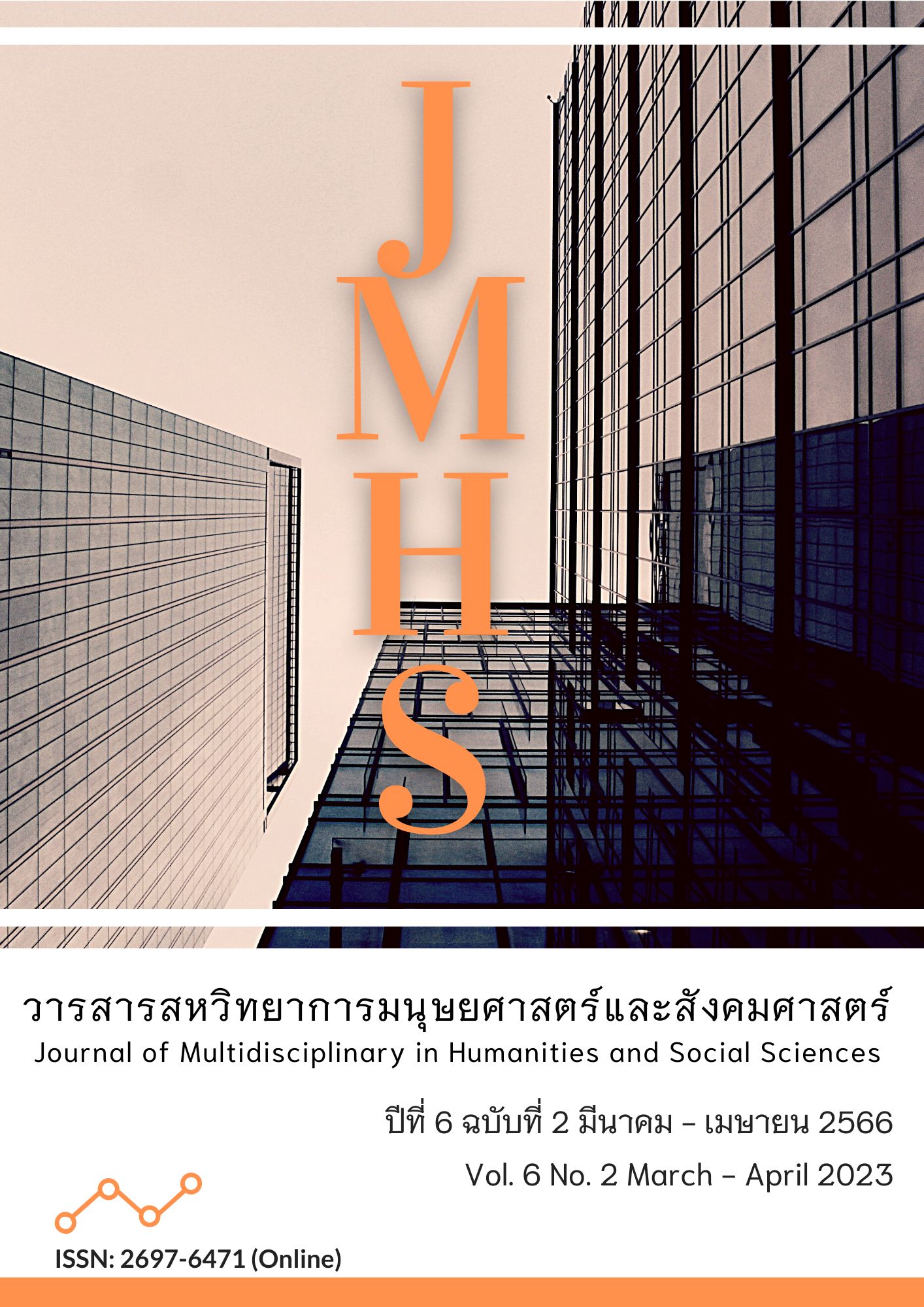พุทธนวัตกรรมภาวนา 4 เพื่อเพิ่มพลังของผู้สูงอายุ อำเภอสามพราน จังหวัดนครปฐม
Main Article Content
บทคัดย่อ
การวิจัยครั้งนี้มีวัตถุประสงค์ 1) เพื่อศึกษารูปแบบพุทธนวัตกรรมภาวนา 4 เพื่อเพิ่มพลังของผู้สูงอายุ อำเภอสามพราน จังหวัดนครปฐม 2) เพื่อพัฒนารูปแบบพุทธนวัตกรรมภาวนา 4 เพื่อเพิ่มพลังของผู้สูงอายุ อำเภอสามพราน จังหวัดนครปฐม และ 3) เพื่อสร้างรูปแบบพุทธนวัตกรรมภาวนา 4 เพื่อเพิ่มพลังของผู้สูงอายุ อำเภอสามพราน จังหวัดนครปฐม คณะผู้วิจัยได้กำหนดใช้วิธีวิจัยแบบผสานวิธี (Mixed Methodology Research) ประกอบด้วย การวิจัยเชิงคุณภาพ (Qualitative Research) เก็บข้อมูลเชิงลึกจากผู้เข้าร่วมกิจกรรม จำนวน 27 คน/รูป และ การสนทนากลุ่มเฉพาะ (Focus-Group Discussion) โดยใช้วิธีคัดเลือกแบบเจาะจง (Purposive Sampling) ทั้งหมด 3 กลุ่ม ประกอบด้วย กลุ่มพระสงฆ์ที่ทำหน้าที่เป็นผู้จัดการวัดอบอบรมเสริมสร้างพลังผู้สูงอายุ, กลุ่มกลุ่มผู้นำชุมชน ชมรมและหน่วยงานที่เกี่ยวข้องกับการดูแลเสริมสร้างพลังผู้สูงอายุ, กลุ่มกลุ่มสมาชิกชมรมผู้สูงอายุ รวมทั้งสิ้น 12 คน/รูป, การวิจัยเชิงปฏิบัติการ (Action Research) ทำการเก็บข้อมูลกับผู้เข้าร่วมกิจกรรมพุทธนวัตกรรมภาวนา 4 เพื่อเพิ่มพลังของผู้สูงอายุ อำเภอสามพราน จังหวัดนครปฐม 15 คน ผลการวิจัยพบว่า ผู้เข้าร่วมกิจกรรม 15 คน จากการเปรียบเทียบค่า paired t-test ทั้งก่อนและหลังเข้าร่วมกิจกรรมจะเห็นว่าทั้งข้อความลักษณะบวก และลักษณะลบ มีผลลัพธ์ที่ดี แสดงเห็นว่า การตอบคำถามของผู้สูงอายุที่เป็นอาสาสมัครมีความเข้าใจเกี่ยวกับพุทธนวัตกรรมภาวนา 4 และให้ความร่วมมือกับกิจกรรมเป็นอย่างดี มีความชัดเจน มีความคิดเห็นและทัศนคติที่ดี มีสติปัญญาที่เฉลี่ยวฉลาดแสดงให้เห็นถึงความเข้าใจเป้าหมายของกิจกรรม
Article Details

อนุญาตภายใต้เงื่อนไข Creative Commons Attribution-NonCommercial-NoDerivatives 4.0 International License.
ทัศนะและความคิดเห็นที่ปรากฏในวารสาร ถือเป็นความรับผิดชอบของผู้เขียนบทความนั้น และไม่ถือเป็นทัศนะและความรับผิดชอบของกองบรรณาธิการ
เอกสารอ้างอิง
ดรุฑ สิทธิรัตน์. (2565). ทักษิณาวรรต: ศิลปะบำบัดในมิติทางพระพุทธศาสนา. วารสารสหวิทยาการมนุษยศาสตร์และสังคมศาสตร์, 5(4), 1571–1582. สืบค้นจาก https://so04.tci-thaijo.org/ index.php/jmhs1_s/article/view/259331
พรพิมล ติ๊บเต็ม. (2565). ปัญหาผู้สูงอายุในการพัฒนาองค์กร. สืบค้นเมื่อ 22 มิถุนายน 2565, จาก http//elderly.blogspot.com/2012 /06/blog-post.html.
พระธรรมโกศาจารย์. (2548). ขอบฟ้าแห่งความรู้กับผลงานด้านการศึกษา. กรุงเทพฯ: สามลดา.
พระธรรมปิฎก. (2547). สัมมาสมาธิและสมาธิแบบพุทธ. กรุงเทพฯ: ธรรมสภาและสถาบันบันลือธรรม.
พระพรหมคุณาภรณ์. (2547). หลักแม่บทของการพัฒนาตน. (พิมพ์ครั้งที่ 15). กรุงเทพฯ: มหาจุฬาลงกรณราชวิทยาลัย.
พระพรหมคุณาภรณ์. (2550). พจนานุกรมพุทธศาสตร์ ฉบับประมวลธรรม. กรุงเทพฯ: จันทร์เพ็ญ.
พระภูชิสสะ ปญฺญาปโชโต. (2562). การเสริมสร้างสุขภาวะตามหลักภาวนา 4 ของผู้สูงอายุในตำบลยางฮอม อำเภอขุนตาล จังหวัดเชียงราย. วารสาร มจร การพัฒนาสังคม, 4(1), 49-50.
พระมหาไกรวรรณ์ ชินทตฺติโย และคณะ. (2560). การบูรณาการหลักพุทธธรรมในการเสริมสร้างสุขภาวะผู้สูงอายุขององค์กรชุมชน อำเภอสามพราน จังหวัดนครปฐม (รายงานการวิจัย). มหาวิทยาลัยมหาจุฬาลงกรณราชวิทยาลัย วิทยาลัยสงฆ์พุทธปัญญาศรีทวารวดี.
พระมหาสุทิตย์ อาภากโร และ สายชล ปัญญชิต. (2558). รูปแบบการเสริมสร้างสุขภาวะและการเรียนรู้ของสังคมตามแนวพระพุทธศาสนา. Veridian E-Journal, Silpakorn University, 8(1), 958-971. สืบค้นจาก https://he02.tci-thaijo.org/index.php/Veridian-E-Journal/article/view/ 31802
พระมหาวีรธิษณ์ อินทะโพธิ์ และ ธานี สุวรรณประทีป. (2565). ความปรารถนาของมนุษย์: บทวิเคราะห์ในมิติพระพุทธศาสนา. วารสารนวัตกรรมการจัดการศึกษาและการวิจัย, 4(1), 29-38. สืบค้นจาก https://so02.tci-thaijo.org/index.php/jemri/article/view/252074
มหาจุฬาลงกรณราชวิทยาลัย. (2539). พระไตรปิฎกฉบับภาษาไทย ฉบับมหาจุฬาลงกรณ
ราชวิทยาลัย. กรุงเทพฯ: โรงพิมพ์มหาจุฬาลงกรณราชวิทยาลัย.
สมศักดิ์ ศรีสันติสุข. (2539). สังคมวิทยาภาวะผู้สูงอายุ:ความจริงและการคาดการณ์ในสังคมไทย.กรุงเทพฯ: จุฬาลงกรณ์มหาวิทยาลัย.
สำนักงานสถิติแห่งชาติ. (2564). สรุปผลที่สำคัญการสำรวจประชากรสูงอายุในประเทศไทย ปี พ.ศ. 2550. สืบค้นเมื่อ 26 มีนาคม 2564, จาก http://service.nso.go.th/nso/nsopublish/themes/
Damnoen, P. S., Siri, P., Supattho, P. S., & Kaewwilai, K. (2021). The Development of Student Characteristics in According to the Nawaluk Framework of the Buddhist integration of Buddhapanya Sri Thawarawadee Buddhist College. Asia Pacific Journal of Religions and Cultures, 5(2), 126–135. Retrieved from https://so06.tci-thaijo.org/index.php/ajrc/article/ view/249662
Ganesh, K. (2005). Made to measure. Dutch elder care at the intersections of policy and culture. In C. Risseeuw., K. Ganesh., and R. Palriwala; Care culture and citizenship. Revisiting the politics of the Dutch welfare state. (pp 116-158). Amsterdam: Het Spinhuis.
Tan, C. C., & Damnoen, P. S. (2020). Buddhist Noble Eightfold Path Approach in the Study of Consumer and Organizational Behaviors. Journal of MCU Peace Studies, 8(1), 1–20. Retrieved from https://so03.tci-thaijo.org/index.php/journal-peace/article/view/235080


